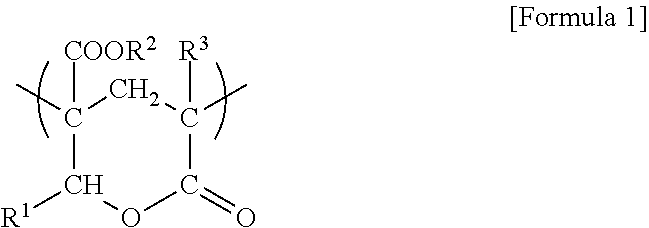Adhesive for polarizing plate, polarizing plate, method for producing same, optical film, and image display device
a technology of adhesives and polarizing plates, applied in the direction of polarizing elements, instruments, other domestic articles, etc., can solve the problems of film torn, peeling at the interface between polarizers, knicks (knick defects), etc., to suppress the occurrence of knicks, increase the yield of polarizing plates, and high adhesion strength
- Summary
- Abstract
- Description
- Claims
- Application Information
AI Technical Summary
Benefits of technology
Problems solved by technology
Method used
Image
Examples
examples 2 to 11
, Comparative Examples 1 to 4, and Reference Example 1
[0114]Aqueous adhesive solutions were prepared by the same method as in Example 1, except that the formulations shown in Table 1 were used instead, respectively. Polarizing plates were prepared as in Example 1, except that the prepared aqueous adhesive solutions were used instead, respectively.
[Measurement and Evaluation]
(Refractive Index of Adhesive Layer)
[0115]The prepared aqueous adhesive solution was applied onto a transparent film using an applicator and dried at 70° C. for 10 minutes to form an adhesive layer. Subsequently, the adhesive layer (5 μm) was peeled off from the transparent film, and the refractive index of the adhesive layer was measured using a prism coupler (SPA-4000, manufactured by Sairon Technology, Inc.)
(Light Transmittance of Polarizing Plate)
[0116]The single transmittance Ts was measured using a spectrophotometer (V7100, manufactured by JASCO Corporation).
(Adhesion)
[0117]The edge of a cutter knife was in...
example 1
[0122]A 75 μm-thick polyvinyl alcohol film with an average degree of polymerization of 2400 and a saponification degree of 99.9% by mole was immersed and allowed to swell in warm water at 30° C. for 60 seconds. The film was then immersed in an aqueous solution of iodine / potassium iodide (0.5 / 8 in weight ratio) at a concentration of 0.3%, while stretched to a stretch ratio of 3.5 times, so that the film was dyed. The film was then stretched in an aqueous borate ester solution at 65° C. such that the total stretch ratio reached 6 times. After the stretching, the film was dried in an oven at 40° C. for 3 minutes, resulting in a polarizer. The single transmittance Ts was measured using a spectrophotometer (V7100, manufactured by JASCO Corporation), and as a result, the light transmittance was 42.50%.
(Transparent Protective Film)
[0123]An 80-μm thick triacetylcellulose (TAC) film was used.
(Preparation of Aqueous Adhesive Solution)
[0124]In pure water were dissolved 100 parts of a ...
PUM
| Property | Measurement | Unit |
|---|---|---|
| refractive index | aaaaa | aaaaa |
| refractive index | aaaaa | aaaaa |
| thickness | aaaaa | aaaaa |
Abstract
Description
Claims
Application Information
 Login to View More
Login to View More - R&D
- Intellectual Property
- Life Sciences
- Materials
- Tech Scout
- Unparalleled Data Quality
- Higher Quality Content
- 60% Fewer Hallucinations
Browse by: Latest US Patents, China's latest patents, Technical Efficacy Thesaurus, Application Domain, Technology Topic, Popular Technical Reports.
© 2025 PatSnap. All rights reserved.Legal|Privacy policy|Modern Slavery Act Transparency Statement|Sitemap|About US| Contact US: help@patsnap.com

